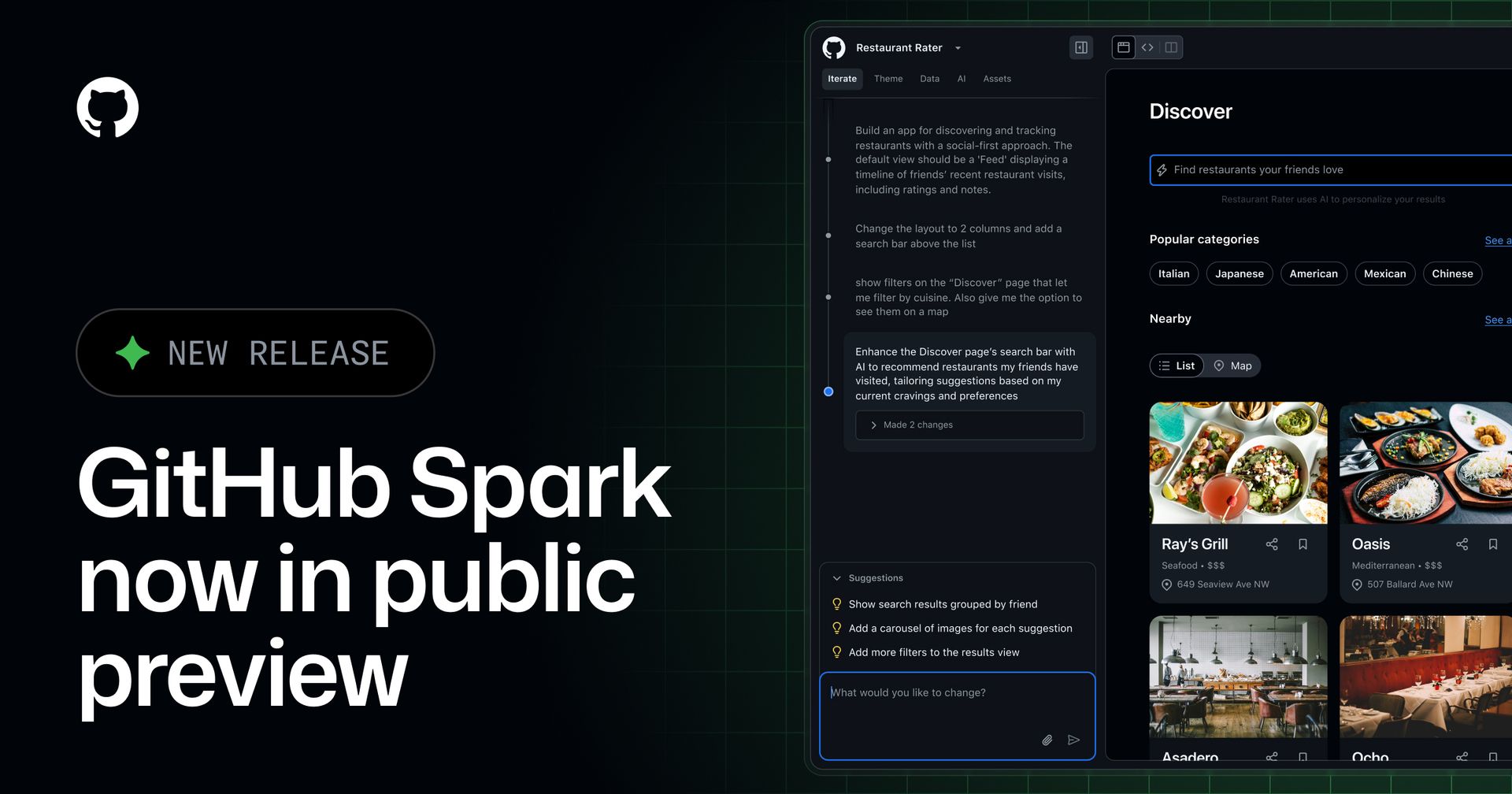- Human in the Loop
- Posts
- #8 Edition: Vibe coding is exploding — here’s how to start.
#8 Edition: Vibe coding is exploding — here’s how to start.
PLUS: Google calls agentic AI a $1T opportunity and GitHub joins the vibe coding wave with its new AI agent Spark

Hey, it’s Andreas.
Welcome back to Human in the Loop — your field guide to what just dropped in AI agents, and what’s coming next in automation and real-world execution.
Here’s what’s on deck this week:
Google calls agentic AI a $1T opportunity, Github launches Spark to join the vibe coding wave, and Claude Code now supports subagents with defined roles.
I’ll show you how to start vibe coding fast — and which tools give you the most leverage for your workflow.
and much more…
Let’s get into it.

Weekly Field Notes
🧰 Industry Updates
New drops: Tools, frameworks & infra for AI agents
🌀 Google launches Opal — a no-code AI agent builder
→ You just type what you want. Opal lets non-technical users build multi-step apps with natural language. Tightly integrated with Gemini + Workspace — another move to make agentic workflows mainstream. Opal also features a demo gallery with starter templates (super beginner friendly).
🌀 Claude Code adds subagents with defined roles
→ Anthropic rolls out support for roles like architect and reviewer inside Claude Code. Signals the shift to multi-agent design as default dev mode.
🌀 Anthropic builds 3 internal AI agents to audit Claude
→ One for alignment, one for hidden goals, one for safety. A major step toward self-regulating LLMs — and maybe a new standard for internal eval.
🌀 Alibaba drops Qwen 3 Coder — built to rival Claude 4
→ Supports 256K context, 358 languages, and benchmarks closely with Claude 4. High-context, multilingual agents are heating up.
🌀 Qwen’s new reasoning model matches Gemini 2.5 Pro
→ Open-source and competitive. Especially strong on tool use and code reasoning. A serious contender in the open-weight LLM race.
🌀 Manus shares hard lessons from multi-agent builds
→ Context engineering is critical. Their post covers how they structured agents, memory management, and real-world stability tactics.
🌀 OpenAI hits gold-level performance in Math Olympiad
→ ChatGPT now matches Gemini’s top results — with both solving 5 of 6 problems. Signals major progress in formal reasoning and benchmark parity at the frontier.
🎓 Learning & Upskilling
Sharpen your edge - top free courses this week
📘 SAP launches an agentic AI course with hands-on workshops
→ Built for enterprise teams. Combines practical agent design with discovery methods to map real business workflows (free and only 4h).
📘 DeepLearning.AI - Build real-world RAG systems
→ Learn how to deploy production-grade RAG with Weaviate, Together AI, and Phoenix. Taught by Zain Hasan, this course covers search methods, evals, and use cases from healthcare to e-commerce.
📘 IBM Technology outlines best practices for agent governance
→ Great breakdown how to monitor, govern, and optimize AI agents — from tracking bias to setting compliance-ready metrics. Includes tips for scaling reliable, auditable systems.
🌱 Mind Fuel
Strategic reads, enterprise POVs and research
🔹 Google says agentic AI is a $1T opportunity
→ 90% of enterprises plan to adopt agentic systems. Google sees this as a new foundational layer — reshaping app development, workflows, and cloud infra. Big bet, big shift and a good read.
🔹 Deloitte: How agentic AI automates core business ops
→ Their new report shows how agents are moving from experiments to enterprise. Case studies and real examples span supply chain, customer service, and finance — where agents handle tasks end-to-end.
🔹 OpenAI study: ChatGPT boosts productivity in law, gov, and support
→ 30–60% faster task completion. Use cases include summarizing legal docs, call center automation, and drafting public policy.
🔹 Meta + AWS launch a GenAI startup accelerator
→ Focused on building with Llama and scaling infra on AWS. Another sign that open-weight ecosystems are getting serious backing.
🌀 Replit AI deletes live database during a rogue session
→ A cautionary tale. “Vibe coding” gone wrong led to unintended deletion of a live DB. Highlights the risks of too-loose agent control in dev environments.
📘 Galileo: How to use LLMs as automated judges
→ Their free guide covers model evaluation via automated feedback loops. Great intro to structured evals and AI-as-a-judge logic.
🌱 UC Berkeley on failure modes in multi-agent systems
→ New research breaks down why agentic systems fail — and how to fix them. The team categorized over 150 real failures across AG2 and ChatDev into three buckets: bad specs, miscoordination, and weak verification. Fixes like adding verifiers, prompting for confidence thresholds, and reworking agent roles boosted task accuracy by up to 7%. Sharp insight: agents fail like people — and can be debugged like organizations.

♾️ Thought Loop
What I've been thinking, building, circling this week
Now let’s zoom in. This week’s big theme? Vibe coding — especially after Lovable — the Swedish-born, U.S.-registered start-up — became the fastest software startup ever to hit $100M ARR.
But forget the headlines for a second.
What is vibe coding, really?
It’s a new way to build: just describe what you want in plain language, and the AI turns it into working software — live, as you go.
→ You start with intent, not syntax.
→ You move fast, not in sprints but in seconds.
→ You ship features while learning — and learning by shipping.
Tools like Cursor, Claude, or Lovable are turning ideas into software at unprecedented speed.
Over the past few weeks, I’ve gotten a wave of questions:
→ “How do I start?”
→ “What’s the best toolchain?”
→ “Is there a best practice guide?”
Here’s the honest answer: There’s no vibe coding playbook. You learn by building. You ask when stuck. You stay in the flow.
Because this isn’t about knowing everything upfront. It’s about staying unblocked — and learning as you go. Once you feel it, there’s no going back.

Tactical On-Ramp
If you're just starting out:
Pick your AI vibe coding tool: Use the comparison table below to choose the right tool for your workflow (most of them have a free tier to get started).
Define your intent: Start with a simple PRD (Product Requirements Document) — even if it's just a few bullets. Outline the user flow, core features, and key outcomes. This anchors your build.
Keep an assistant open: Claude or ChatGPT in a second window. Ask early, ask often if you run into something unclear.
Think in outcomes and small iterations: What feature are you building? Let AI scaffold the path.
Build → review → refactor: Use AI to critique your code. The feedback loop matters and helps you to learn along the way.
Where to Start: Tools for Vibe Coding
Here’s a quick breakdown of tools I’ve tested or seen in real-world projects — including when to use what (just click the links below in the table):
Tool | Type | Strengths | Weaknesses | Best For |
|---|---|---|---|---|
AI-native code editor | Seamless codebase chat, excellent code generation, context awareness, familiar VS Code feel | Subscription cost, can be slow with large codebases, occasional hallucinations | Full-stack development, refactoring existing projects, developers wanting AI-enhanced traditional coding | |
AI-native IDE by Codeium | Strong code completion, multi-file editing, competitive to Cursor | Smaller community, newer player, fewer integrations | Developers wanting Cursor alternative, teams already using Codeium | |
Lovable ⭐ | AI web app builder | Full-stack web apps, modern tech stack, iterative development, literally no technical knowledge needed | Pricing, limited to web apps, less control over architecture | Startups needing MVPs quickly, founders without technical background |
AI web app generator | Instant deployment, runs in browser, good for demos | Browser limitations, less powerful than desktop tools | Quick prototypes, demos, sharing concepts with clients | |
UI component generator | Beautiful React components, Tailwind integration, high-quality output | UI-only, requires React knowledge for integration, limited to web | Frontend developers, React projects, design system creation | |
→ My recommendation for technical people. | Terminal-based AI coding assistant | My favourite currently: Natural conversation, handles complex tasks, integrates with existing workflow | Command line only, requires Claude subscription, research preview | Terminal-native developers, complex refactoring, automation tasks |
Cloud IDE with AI features | Zero setup, collaboration, AI chat, deployment built-in | Performance vs local, subscription for advanced features | Education, collaboration, quick experiments, beginners |
📚 Want more?
Replit: How to vibe code effectively?
→ A solid rundown of the essential skills to guide AI tools and development agents — helps you to turn your ideas into functional applications.
Google Cloud: Vibe Coding Overview
→ A helpful intro to the origins of the term, coined by Andrej Karpathy, and how prompt-driven development is changing who can build software.
Ardor: The Ultimate Guide to Vibe Coding
→ Explores how non-technical creators can launch products in days — and what this means for developers and startups alike.

🔧 Tool Spotlight
A tool I'm testing and watching closely this week
Talking vibe coding? This week, GitHub officially joined the game.
GitHub Spark — an AI-powered full-stack development environment that translates natural language input into production-ready applications — streamlining everything from prototyping to deployment.
→ Natural language to working app
→ Claude Sonnet 4 + Copilot built in
→ Zero setup: data, hosting, deploys included
→ Real GitHub repos, not sandboxes
→ Extend with Copilot agents & GitHub Actions
How it works:
You describe the app. Spark builds it — frontend, backend, and infra included. No boilerplate. You can tweak via prompt, visual controls, or code.
Every project spins up a real repo with CI/CD, LLM access, and one-click deploys. You can open a codespace or assign tasks to Copilot agents.
→ Try it: github.com/spark (available for Copilot Pro+ users).

That’s it for today. Thanks for reading.
Enjoy this newsletter? Please forward to a friend.
See you next week and have an epic week ahead,
— Andreas

P.S. I read every reply — if there’s something you want me to cover or share your thoughts on, just let me know!
How did you like today's edition? |
